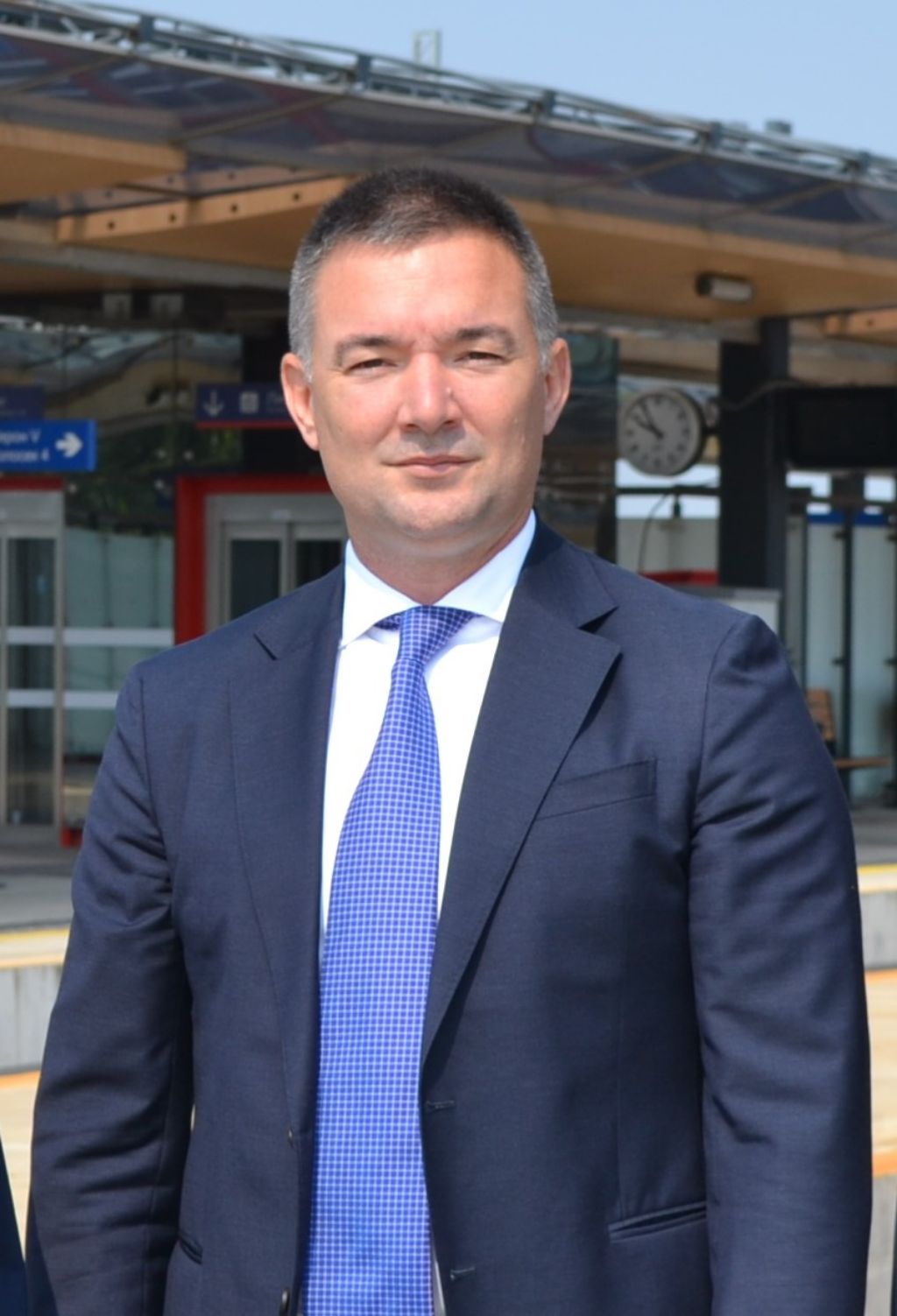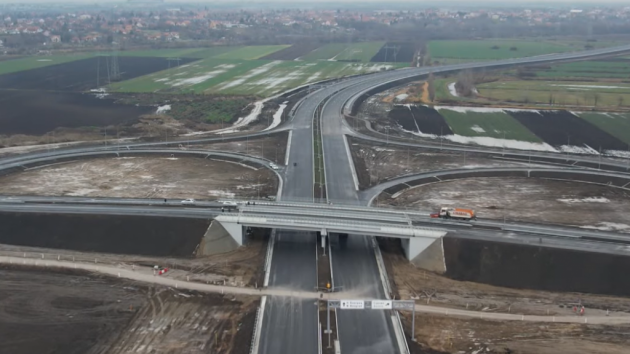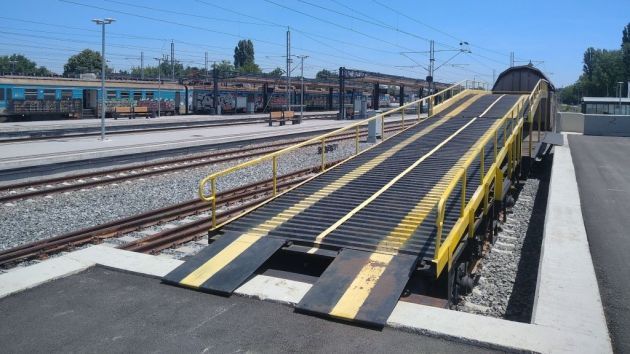Ivan Bulajic, Acting Director General of Srbija Voz – Swiss Trains to Arrive First, Probably Followed by Chinese Trains, Also Seeking a Solution for City Rail System
Source: eKapija
 Monday, 16.10.2023.
Monday, 16.10.2023.
 15:20
15:20
 Monday, 16.10.2023.
Monday, 16.10.2023.
 15:20
15:20
Ivan Bulajic, the acting director general of Srbija Voz (Photo: Medija centar Železnice Srbije)

– We are trying to copy the model we have implemented so successfully on the Belgrade-Novi Sad line to other lines too, wherever possible. The biggest advance for us in terms of the volume of the traffic and the number of people covered by the service, not counting the Belgrade-Subotica line, will be the Nis-Leskovac line, also to be operated by an intercity train. We want to establish a direct connection which will mean a lot to the citizens of those two cities. At the moment, there are works on the part of that railway from Nis to Brestovac and, when they are done, we will have a good electrified connection between Nis and Leskovac, which enables us to implement that level of service.
eKapija: The procurement of 18 Swiss Stadler Flirt trains of the latest generation, carried out in 2021, is financed from the EBRD loan with EUR 112 million. What makes these Flirts different compared to those which are used on Serbian railroads?
– That is one in the range of projects we work on with the EBRD, which supports us very well. Those new trains are necessary, because the traffic sector is expanding rapidly. The new Flirt trains, compared to those we already use, differ in passenger comfort, which is what’s most important to us anyway. In the first series of Flirts, there is only one toilet per train, so if a problem occurs, the train has no toilet. That is why the new trains have two toilets. The second new feature is that we will have vending machines where the passengers will be able to buy refreshments or snacks, because we have lines where a trip takes up to three hours. For example, Belgrade-Uzice, or Belgrade-Prijepolje, these are lines where it’s not normal for a passenger to have no opportunity to buy refreshments if they get thirsty. In addition to that, there are 20 seats more in the new Flirts, and the interior design is done in line with the highest global standards.
eKapija: When can the first one be expected to be delivered?
– Five have been produced and five are meant to be sent for type testing, which has already started. I believe that it would be realistic to expect the first of those trains to be included in the traffic on the first line in April or May next year.
The existing three Stadler Kiss trains will not be sufficient once the railroad to Nis is built (Photo: Srbija voz promo)

eKapija: There is a fast railroad being built toward Subotica, and one is planned toward Nis as well. Is there a plan to procure more trains for speeds of up to 200 kilometers per hour?
– Both types of trains will operate all those railroads, except that, where railroads for up to 200 km/h are built, the trains which can run at that speed will be used. Due to the frequent stops, regio express has no real need to run at over 160 km/h. In general, we are a small country and, at the railroad length we have, not much is gained with that difference of 40 km/h. Bu definitely, in order to have a good connection from Nis through Belgrade and Novi Sad to Subotica and then farther to Budapest, we will have to procure more of those trains which can run at up to 200 km/h.
eKapija: The three that we already have will not be enough?
– No. They will still be sufficient even when the section to Subotica is finished, but they will certainly not be sufficient once the fast railroad to Nis is finished. When the Hungarian part of the railroad from Subotica to Budapest is finished, the existing trains we have for speeds up to 200 km/h will not be sufficient either. There are two models for procuring trains. One is for Srbija Voz, in cooperation with international finance institutions, to be the purchaser, to secure the financing by the Republic of Serbia giving a guarantee for that debt to the EBRD, and them signing the financing agreement directly with us. That’s the way it was done for these 18 trains. There is another option too, which is for the state to be the purchaser of the trains directly through the Ministry of Finance, and then, once they are procured, for them to be transferred into Srbija Voz’s ownership. Negotiations are ongoing with one of the world’s best train manufacturers, which is the Chinese company CRRC. There are talks about the potential procurement of five fast trains for speeds of up to 200 km/h. There has been plenty of progress in those negotiations, which the Republic of Serbia is having with the People’s Republic of China and I expect an agreement to be signed soon and the agreements on the delivery of those trains to start being valid.
eKapija: So, the next new fast trains might come from China?
– That’s where things are heading at the moment. I believe that Srbija Voz is in an unprecedented investment cycle. There are the 18 Flirts that are supposed to be delivered, there are negotiations about these five fast trains, and I expect the procurement procedure for the new trains for the city rail system of Belgrade to be initiated as soon as at the beginning of the next year.
eKapija: Is it known who the negotiations will be had with about that as well?
– No, it is too soon to know, because at the moment, we don’t even know which model will be implemented. But it is clear that it is no longer possible to properly maintain the trains that we use for the city railroad. Those trains are over 40 years old, made in the USSR. There are no more spare parts, the technology is obsolete, they consume much more electrical energy than the new-generation trains. There is no sense in extending the life cycle of that series any more. I expect the state will make the decision to go in that direction, to get new trains for the city rail system, because that is also important for EXPO 2027, as an extension of the line from Zemun Polje is planned, which will service the Airport, the National Stadium and the EXPO zone. Also, in general, we have to provide the residents of Belgrade with a much better service than has been the case so far. And then there’s the question of international traffic using traditional means of transport, because all the things that we are procuring now are electric trains, that is, trains in one piece, which cannot be divided into the rail cars and the locomotive.
eKapija: The agreeing of a credit line for the purchase of new electric trains has been announced. What will this procurement entail in concrete terms?
– We have a fleet of some 59 rail cars and 13 electric train engines. That fleet is very outdated and in a bad condition. Those locomotives are over 40 years old, and the youngest rail cars date back to the early 2000s. In general, when it comes to rail cars, that is not considered old, but we have 22 of them, whereas the rest of the rail cars are very old, often up to 50 years. And in order to be able to seriously establish rail traffic toward the markets that are interesting to us, primarily Austria and Switzerland, and even Hungary, which has one of the fastest growing tourism offers in Europe, we have to consider the renewal of these means of transport as well. We are negotiating with EUROFIMA, the European bank for rolling stock financing, about a loan of EUR 90 million for the purchase of the most modern locomotives, which can run at 200 km/h, which have an ETCS system on modern railroads. In addition to that, we are having these 22 younger rail cars undergo a major overhaul, which entails a full renewal, so that only the “shell” remains of the old one and to thereby get 22 fully new rail cars. The plan is to also get sleeping rail cars. We will thereby have new locomotives, sleeping rail cars with enough seats to be able to travel through Budapest to Western Europe and to reach Ljubljana through Zagreb, because it’s easy to make a connection from there. On top of all that, there’s also the project with the EBRD of EUR 51 million for a full modernization of the full maintenance at the Technical-Passenger Station (TPS) Zemun, as well as the fact that we recently signed an additional EUR 25 million with the EBRD for the modernization of the remaining depots, so that, with the maintenance network, we would form a whole which would follow the route of Corridor 10. When all this is put together, it is truly an unprecedented volume of investments in Srbija Voz, with the help of the state, plus these Chinese trains, which I believe will cost us around EUR 60 million.
eKapija: When it comes to the agreement with the EBRD for the construction and renewal of train maintenance depots outside of Belgrade too, what exactly does it encompass?
– The main thing and two thirds of that amount will be put into the construction of a whole new depot in Nis. There, with the completion of the fast railroad towards the country’s south, the second most important rail hub in the country will be created, which will not be much behind the one in Belgrade. There is the already mentioned reconstruction of the Nis-Brestovac railroad, which will connect Nis and Leskovac, and electrification between Stalac and Kraljevo is planned too. The modernization of the branch toward Dimitrovgrad is in progress as well. A half of the overhaul has been done, and now the other half of the railroad, from Nis to Zejecar is being done. It will, however, not be electrified, but the section from Nis to North Macedonia and Greece, as well as toward Sofia, will be. There will also be a connection between Pozega and Nis. On the other hand, when it comes to Belgrade, there will be the electrified Vrsac railroad, the modernized Nis railroad, the section toward Bar and the one toward Subotica. The volume of traffic that will be present in Belgrade will be equaled by the south. That is why, with the depot in Lapovo, which is the closest one to Nis, and the one in Zajecar, which are in a very bad condition and outdated, we can’t adequately cover the traffic volume that is expected in Nis. That is why we now have to start the investment in the construction of a new depot. It will be built in line with the highest standards, the kind that are present in Western Europe. Also, using that loan, in Zemun, we will complete the part that was not covered by the initial credit – Hall 13. In Sombor as well, we will do a very thorough modernization of the depot, so as to increase its capacity. That is especially important, because the connection between Corridor 10 and Sombor will be electrified as well, so we will get three top-quality depots in the northern, central and southern parts of the country. The remaining depots will be financed from our own funds.
(Photo: Srbija voz)

eKapija: Due to the current railroad reconstruction, we have no connection with Budapest, but what are the key problems that are causing us to almost have no international passenger traffic for years now? Not so long ago, we had trains going to Vienna, Villach, Zagreb, Ljubljana, Thessaloniki, Sofia…
– The main problem is the infrastructure. The condition of the railroads. The route to Croatia is always highlighted the most, I guess because of the politics. To be honest, I don’t believe that is our main international route. I believe that the route through Budapest will be much more useful to us. However, speaking of the route to Croatia, the railroad to Sremska Mitrovica is in a good condition, but the section from Sremska Mitrovica to Sid is in a very bad condition. The project of the modernization of that railroad is upcoming, we will see whether it will be designed for 160 or 200 km/h. However, in the Croatian territory, they are carrying out works that will last all the way to 2023, between Zagreb and Nis. It is not a priority route for them. I believe that their priority is to connect Zagreb farther with Western Europe, and the situation there is not optimistic. Travel times to Zagreb with the current infrastructure are very long, so it’s not likely that we would achieve any major commercial success there at the moment. And as I’ve already said, our trains for those routes, the rail cars and locomotives, are in such a condition that, when strict control is applied at the border, they can immediately find a reason to exclude our vehicles from traffic and thereby automatically place a barrier for us to enter that market. That is one of the reasons why we have reoriented toward Budapest. By arriving to Budapest, with one transfer, there is a train every hour toward Western Europe. That is the reality, but as soon as next year, when the first rail cars are sent back from the overhaul, we will see what the new excuse is. But even besides that, the travel times will be the main problem on that route.
eKapija: What about the international lines toward Thessaloniki and Sofia?
– Those are two completely different situations. As soon as the section from Nis to Dimitrovgrad is completed, which I believe will happen in two to three years, we will be able to travel directly from Nis to Sofia. When that happens, a direct line from Belgrade will not yet be available, because of the reconstruction of the railroad from Belgrade to Nis, but certainly from Nis to Sofia, where there is the biggest passenger demand anyway. On the day that railroad opens, our new trains will be ready for that route. North Macedonia is a whole other subject. The works between Nis and Tabanovce are not even planned at the moment, and plenty depends on the Macedonian side there. That is why, on that section, we are counting on cargo transport more than on passenger transport.
eKapija: International transport, then, depends a lot on other countries as well?
– Unfortunately, yes.
Renewable sources considered
eKapija: Is Srbija Voz looking a little further into the future? Are you already considering long-term investments in innovative solutions, such as hybrid means of transport or renewable energy sources?
– In the past period, we have been in contact with colleagues from Great Britain regarding the research of alternative drives. We did consider a project whereby diesel motor vehicles would be converted to hydrogen. However, we concluded that the prices of converting such trains to hydrogen, entailing a tank under pressure where hydrogen is stored, but also the prices of the infrastructure that it would require, were still too high. We have abandoned that at the moment, but just like every serious operator, we are still considering it. Besides, there is still no European standard regarding what the pressure should be, expressed in bars. What I’m trying to say is that there’s a risk when it comes to investing in something like that. What I believe is on the rise at the moment is electrification. Soko, plus Vrsac and Kraljevo, when everything I’ve talked about is done – we will be in a much, much better position. Especially when it comes to the kind of environmental protection we get with electrification.
Dejan Aleksic
Companies:
 Vlada Republike Srbije
Vlada Republike Srbije
 Ministarstvo građevinarstva, saobraćaja i infrastrukture Republike Srbije
Ministarstvo građevinarstva, saobraćaja i infrastrukture Republike Srbije
 Ministarstvo finansija Republike Srbije
Ministarstvo finansija Republike Srbije
 EBRD Evropska banka za obnovu i razvoj Beograd
EBRD Evropska banka za obnovu i razvoj Beograd
 Grad Zaječar
Grad Zaječar
 Opština Šid
Opština Šid
 Opština Prijepolje
Opština Prijepolje
 Grad Subotica
Grad Subotica
 Opština Dimitrovgrad
Opština Dimitrovgrad
 Grad Kraljevo
Grad Kraljevo
 Grad Sremska Mitrovica
Grad Sremska Mitrovica
 Gradska opština Surčin
Gradska opština Surčin
 Grad Niš
Grad Niš
 Grad Novi Sad
Grad Novi Sad
 Grad Leskovac
Grad Leskovac
 Grad Beograd
Grad Beograd
 A.D. Aerodrom Nikola Tesla Beograd
A.D. Aerodrom Nikola Tesla Beograd
 Infrastruktura Železnice Srbije Beograd
Infrastruktura Železnice Srbije Beograd
 Air Serbia ad Beograd
Air Serbia ad Beograd
 Srbijavoz a.d. Beograd
Srbijavoz a.d. Beograd
Tags:
Eurofima
TPS Zemun
CRRC
Stadler
Brestovac
Zemun polje
Stalać
Vienna
Bar
Bijelo Polje
Tabanovce
Zagreb
Ljubljana
Villach
Sofia
Thessaloniki
Ivan Bulajić
Corridor 10
USSR
Western Europe
rail station Novi Sad
rail station Niš
rail station Zemun
rail station Zaječar
depot Sombor
depot Niš
depot Lapovo
depot Zaječar
Kiss
Flirt
electric trains
rail cars
locomotives
trains
sleeping rail cars
BG voz
city rail system
railroad
tracks
credits
loans
EXPO 2027
finances
investments
repair
overhaul
vending machines
international traffic
internal traffic
hydrogen
application
renewable energy sources
RES
ETCS system
cargo transport
Comments
Your comment
Naš izbor
Most Important News
Full information is available only to commercial users-subscribers and it is necessary to log in.
Follow the news, tenders, grants, legal regulations and reports on our portal.
Registracija na eKapiji vam omogućava pristup potpunim informacijama i dnevnom biltenu
Naš dnevni ekonomski bilten će stizati na vašu mejl adresu krajem svakog radnog dana. Bilteni su personalizovani prema interesovanjima svakog korisnika zasebno,
uz konsultacije sa našim ekspertima.


 Izdanje Srbija
Izdanje Srbija Serbische Ausgabe
Serbische Ausgabe Izdanje BiH
Izdanje BiH Izdanje Crna Gora
Izdanje Crna Gora


 News
News








